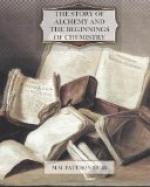There was, then, a certain degree of accuracy in the alchemical description of the processes we now call chemical changes, as being the removal of the outer properties of the things which react, and the manifestation of their essential substance. But there is a vast difference between this description and the chemical presentment of these processes as reactions between definite and measurable quantities of elements, or compounds, or both, resulting in the re-distribution, of the elements, or the separation of the compounds into their elements, and the formation of new compounds by the re-combination of these elements.
Let us contrast the two descriptions somewhat more fully.
The alchemist wished to effect the transmutation of one substance into another; he despaired of the possibility of separating the Elements whereof the substance might be formed, but he thought he could manipulate what he called the virtues of the Elements by a judicious use of some or all of the three Principles, which he named Sulphur, Salt, and Mercury. He could not state in definite language what he meant by these Principles; they were states, conditions, or qualities, of classes of substances, which could not be defined. The directions the alchemist was able to give to those who sought to effect the change of one thing into another were these. Firstly, to remove those properties which characterised the thing to be changed, and leave only the properties which it shared with other things like it; secondly, to destroy the properties which the thing to be changed possessed in common with certain other things; thirdly, to commingle the Essence of the thing with the Essence of something else, in due proportion and under proper conditions; and, finally, to hope for the best, keep a clear head, and maintain a sense of virtue.
If he who was about to attempt the transmutation inquired how he was to destroy the specific properties, and the class properties, of the thing he proposed to change, and by what methods he was to obtain its Essence, and cause that Essence to produce the new thing, he would be told to travel along “the road which was followed by the Great Architect of the Universe in the creation of the world.” And if he demanded more detailed directions, he would be informed that the substance wherewith his experiments began must first be mortified, then dissolved, then conjoined, then putrefied, then congealed, then cibated, then sublimed, and fermented, and, finally, exalted. He would, moreover, be warned that in all these operations he must use, not things which he could touch, handle, and weigh, but the virtues, the lives, the souls, of such things.




